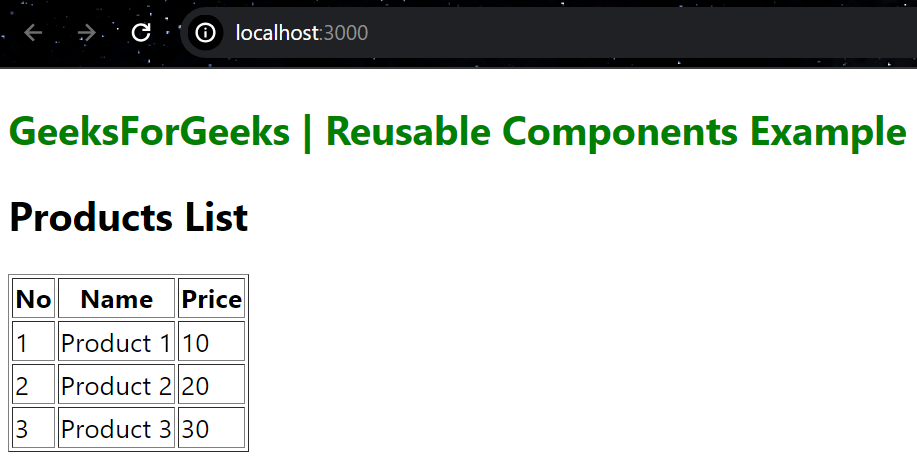

How to make Reusable React Components ?
source link: https://www.geeksforgeeks.org/how-to-make-reusable-react-components/
Go to the source link to view the article. You can view the picture content, updated content and better typesetting reading experience. If the link is broken, please click the button below to view the snapshot at that time.
ReactJS is aJavaScript library used to build single-page applications (SPAs). React makes it easy to create an interactive user interface by using a component-based approach. In this article, we will learn about Reusable React Components with examples.
What are Reusable React Components ?
Reusable React Components are pieces of code that can be shared and reused across different files in your application. It is a modular piece of UI that takes data from props to build complex and interactive user interfaces. It encapsulates the login that can be reused again.
Features of reusable components:
- It can accept props data to customize according to data.
- It can be used to encapsulate the same logic and reuse it again.
- It helps us to break the code into smaller units that can be reused again.
- It makes it easy to maintain the application.
How to make Reusable React Components ?
When creating reusable React components, it’s important to keep in mind two key factors:
1. Avoid side Effects:
It is not recommended to include logic that interacts with external data, such as making API calls, directly inside a reusable component. Instead, you should pass this logic as props to the component.
For example, if a button not only has a visual function but also fetches data from the internet, it may not be reusable in other contexts.
In this case, we have a reusable button component that lacks best practices. In the example section, I will demonstrate why this is the case.
// It is a Reusable ButtonReusable component and this is a bad practicesconst ButtonReusable = () => {return (<button> Click Me </button>);}
2. Use Props:
Props are parameters passed to a component to customize its behavior and appearance, making it reusable for different purposes.
// It is a buttonReusable component that can change its colorconst ButtonReusable = ({ color }) => {return (<button style={{ backgroundColor: blue }}> Click Here </button>);}
This is considered bad practice because the label on the button is fixed as “Click Here“. If you wish to change the text on your button to, for example, “Sign Up“, you would have to go back to the button component and make that change. This means that every time you want to use a different text, you would have to edit the code again. In other words, the button would no longer be reusable.
Steps to Create a React Application:
Step 1: Create a React application using the following command:
npx create-react-app gfg
Step 2: After creating your project folder(i.e. gfg), move to it by using the following command:
cd gfg
Example: This below example demonstrate the Reusable React Components.
In this example, You can see ProductList and ProductItem component can be composed together and accept props for customization and are reusable with different data sets.
JavaScript
//File path: src/App.js
import React from 'react';
import ProductList from './ProductList.js';
const App = () => {
const products = [
{ id: 1, name: 'Product 1', price: 10 },
{ id: 2, name: 'Product 2', price: 20 },
{ id: 3, name: 'Product 3', price: 30 },
];
return (
<div style={{ margin: '5px' }}>
<h2 style={{ color: 'green' }}>
GeeksForGeeks | Reusable Components Example
</h2>
<ProductList products={products} />
</div>
);
};
export default App;
JavaScriptJavaScript
To run the application use the following command:
npm run start
Output: Now go to http://localhost:3000 in your browser

“This course was packed with amazing and well-organized content! The project-based approach of this course made it even better to understand concepts faster. Also the instructor in the live classes is really good and knowledgeable.”- Tejas | Deutsche Bank
With our revamped Full Stack Development Program: master Node.js and React that enables you to create dynamic web applications.
So get ready for salary hike only with our Full Stack Development Course.
Recommend
About Joyk
Aggregate valuable and interesting links.
Joyk means Joy of geeK